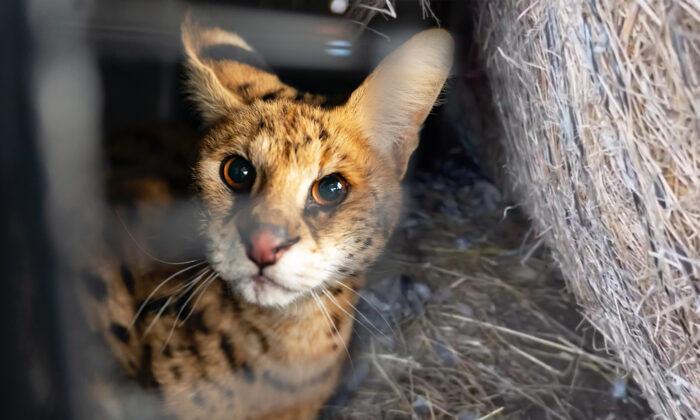An unusual-looking cat running wild on Missouri farmland was humanely trapped by a farmer who discovered, with the help of a wildlife refuge, that this was no local species but an African serval. The cat had survived for months, despite the cold weather, but now has a safe place to call home.
Tanya Smith, president of Turpentine Creek Wildlife Refuge (TCWR) in Eureka Springs, Arkansas, was contacted on Jan. 17. by an Ozark Mountains farmer near Ava, Missouri. Within an hour, the team at Turpentine Creek had their rescue gear loaded and were on the road. The farmer had set up a humane trap on Jan. 14 and successfully caught the cat after just 12 hours, having spotted her several times over the past six months.

“It was amazing that this young serval could survive six months like she has, but she obviously was successful by the amount of bird feathers we found onsite,” Smith said in a statement. “Luckily for this serval, the people that trapped it took very good care of it. They fed it some venison, gave it fresh water, and took it to their local veterinarian ... [but] where she came from is a mystery.”

While “hissy”—it did charge the fence once—the serval transferred easily into the TCWR rescue team’s transport crate. After a two-hour drive, she reached the refuge’s 459-acre property.
“The veterinarian could not find a microchip,” Smith said in a statement. “We don’t know if she was an attempted domestication as a pet and was released, or even part of a backyard breeding scheme and escaped.”

The serval was moved into a quarantine enclosure at TCWR’s Jackson Memorial Veterinary Hospital onsite at the refuge. She quickly began eating and drinking normally, was seen playing in her mulch bed, and appeared to be calm.
Adult servals can stand two feet tall and weigh between 20 and 40 pounds (9-18 kg). With their ability to jump as high as 12 feet, they can catch birds in flight from the air with their razor-sharp teeth.

Servals are native to the African savannah and thrive in warm, dry climates, but have been illegally smuggled into the United States to breed with domestic cats and create the hybrid Savannah cat. TCWR warns that solitary servals are predators, not pets.
Four of the ten resident servals at TCWR were relinquished by former owners, and the rescue team has been involved in numerous serval rescue operations nationwide.

In October 2019, a male serval named Hunter was rescued by the New Mexico Department of Game & Fish from a park near Santa Fe. His front paws had been declawed. Two years later, a woman in Brookhaven, Georgia, reported that a serval had leaped into her bed in the early hours of the morning after her family had opened the door to let their dog out.
In December of the same year, a family from Escondido, California, called the police to report a serval in their bathroom. In January 2022, a 40-pound, 4-year-old serval was found wandering the streets of Lincoln, Massachusetts. Reports of African servals on the loose are increasing in number every year.
Once loose, it can be very hard to capture and confine servals, according to TCWR. They are sharp, intelligent cats; one serval reported missing in Vancouver, British Columbia, had even learned how to open doors by herself.

This most recently rescued female serval may have accrued some street smarts from her time in the wild but she no longer has to fend for herself or brave the bitter cold. She has a safe, forever home at the refuge.





